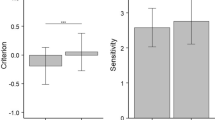Abstract
Three experiments (N = 90; N = 78; N = 52) examined the communicative and remedial properties of blushing. In Experiments 1 and 2, participants read scripts describing incidents that took place in shops. Following the mishap the actor left while displaying a blush (target condition), left the shop without overt signs of shame or embarrassment (baseline condition), or left while displaying shame by nonverbal behaviors other than blushing (comparison condition). Participants were put in the perspective of a shopping observer and were asked to evaluate the actor and the incident. Blushing clearly attenuated the negative evaluation of the incident, lowered the responsibility of the actor, and sustained the actor's trustworthiness. The remedial effects of blushing were even stronger than those of glancing about with the expression of shame. Experiment 2 explored what type of message may elicit these remedial effects and showed that blushing communicates that the actor is strongly attached to the observer's rules, despite the current violation. Experiment 3 provided further evidence for a communicative account of blushing by showing that the actors' blush probability estimates varied as a function of the degree to which the actors shared the rules of the observers. The present findings fit comfortably within a conceptualization of blushing as a remedial gesture.
Similar content being viewed by others
References
Bögels, S.M., Alberts, M., & de Jong, P.J. (1996). Self-consciousness, self-focused attention, blushing propensity and fear of blushing. Personality and Individual Differences, 21, 573–581.
Bögels, S.M., Mulkens, S., & de Jong, P.J. (1997). Task concentration training and fear of blushing. Clinical Psychology and Psychotherapy, 4, 251–258.
Castelfranchi, C., & Poggi, I. (1990). Blushing as a discourse: Was Darwin wrong? In W.R. Crozier (Ed.), Shyness and embarrassment: Perspectives from social psychology (pp. 230–251). Cambridge: Cambridge University Press.
Cutlip II, W.D., & Leary, M.R. (1993). Anatomic and physiological bases of social blushing: speculations from neurology and psychology. Behavioral Neurology, 6, 181–185.
Darwin, C. (1989). The expression of the emotions in man and animals. New York: New York University Press. (Original work published in 1872)
de Waal, F.B.M. (1989). Peacemaking among primates. Cambridge: Harvard University Press.
de Waal, F.B.M. (1995). Good natured: The origins of right and wrong in humans and other animals. Cambridge: Harvard University Press.
Drummond, P.D. (1997). The effect of adrenergic blockade on blushing and facial flushing. Psychophysiology, 34, 163–168.
Edelmann, R.J. (1990). Chronic blushing, self-consciousness, and social anxiety. Journal of Psychopathology and Behavioral Assessment, 12, 119–127.
Frank, R.H. (1988). Passions within reason—The strategic role of the emotions. New York: Norton.
Goffman, E. (1967). Interaction ritual: Essays on face-to-face behavior. Garden City: Anchor.
Goodhart, C.B. (1960). The evolutionary significance of human hair patterns and skin colouring. Advancement of Science, 17, 53–59.
Keltner, D. (1995). Signs of appeasement: evidence for the distinct displays of embarrassment, amusement, and shame. Journal of Personality and Social Psychology, 68, 441–454.
Keltner, D., & Buswell, B.N. (1997). Embarrassment: its distinct form and appeasement functions. Psychological Bulletin, 122, 250–270.
Keltner, D., & Buswell, B.N. (1996). Evidence for the distinctness of embarrassment, shame, and guilt: a study of recalled antecedents and facial expressions of emotion. Cognition and Emotion, 10, 155–171.
Keltner, D., Young, R.C., & Buswell, B.N. (1997). Appeasement in human emotion, social practice, and personality. Aggressive Behavior, 23, 359–374.
King, J.C. (1981). The biology of race. Berkeley: University of California Press.
Leary, M.R., Britt, T.W., Cutlip II, W.D., & Templeton, J.L. (1992). Social Blushing. Psychological Bulletin, 112, 446–460.
Leary, M.R., Landel, J.L., & Patton, K.M. (1996). The motivated expression of embarrassment following a self-presentational predicament. Journal of Personality, 64, 619–636.
Mellander, S., Andersson, P., Afzelius, L., & Hellstrand, P. (1982). Neural beta-adrenergic dilatation of the facial vein in man: Possible mechanisms in emotional blushing. Acta Physiologica Scandinavia, 114, 393–399.
Parkinson, B., & Manstead, A.S.R. (1993). Making sense of emotion in stories and social life. Cognition and Emotion, 7, 295–323.
Semin, G.R. (1982). The transparency of the sinner. European Journal of Social Psychology, 12, 173–180.
Semin, G.R., & Manstead, A.S.R. (1982). The social implications of embarrassment displays and restitution behavior. European Journal of Social Psychology, 12, 367–377.
Shields, S.A., Mallory, M.E., & Simon, A. (1990). The experience and symptoms of blushing as a function of age and reported frequency of blushing. Journal of Nonverbal Behavior, 14, 171–187.
Simon, A., & Shields, S.A. (1996). Does complexion color affect the experience of blushing? Journal of Social Behavior and Personality, 11, 177–188.
Tangney, J.P., Miller, R.S., Flicker, L., & Barlow, D.H. (1996). Are shame, guilt, and embarrassment distinct emotions? Journal of Personality and Social Psychology, 70, 1256–1264.
Author information
Authors and Affiliations
Rights and permissions
About this article
Cite this article
de Jong, P.J. Communicative and Remedial Effects of Social Blushing. Journal of Nonverbal Behavior 23, 197–217 (1999). https://doi.org/10.1023/A:1021352926675
Issue Date:
DOI: https://doi.org/10.1023/A:1021352926675




